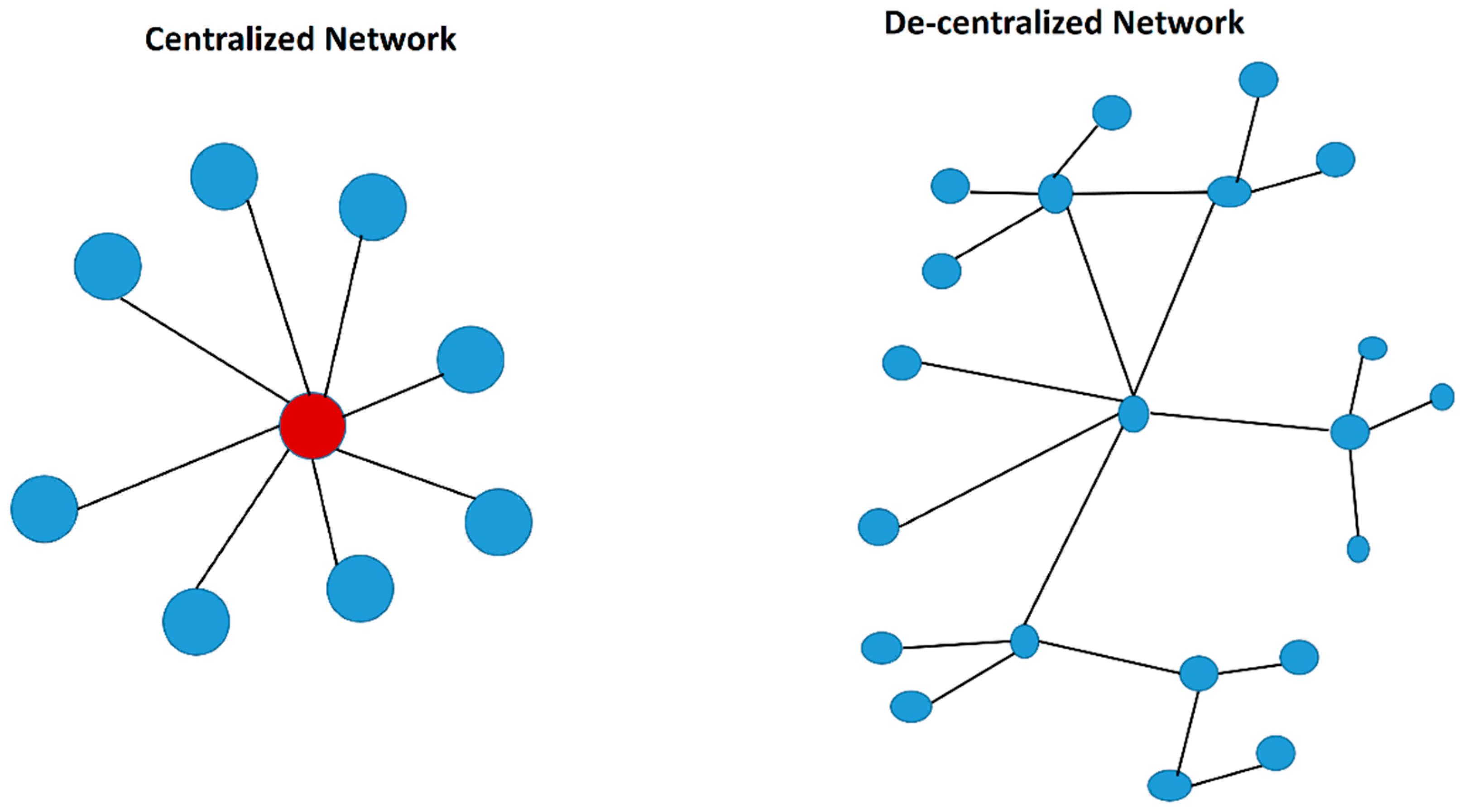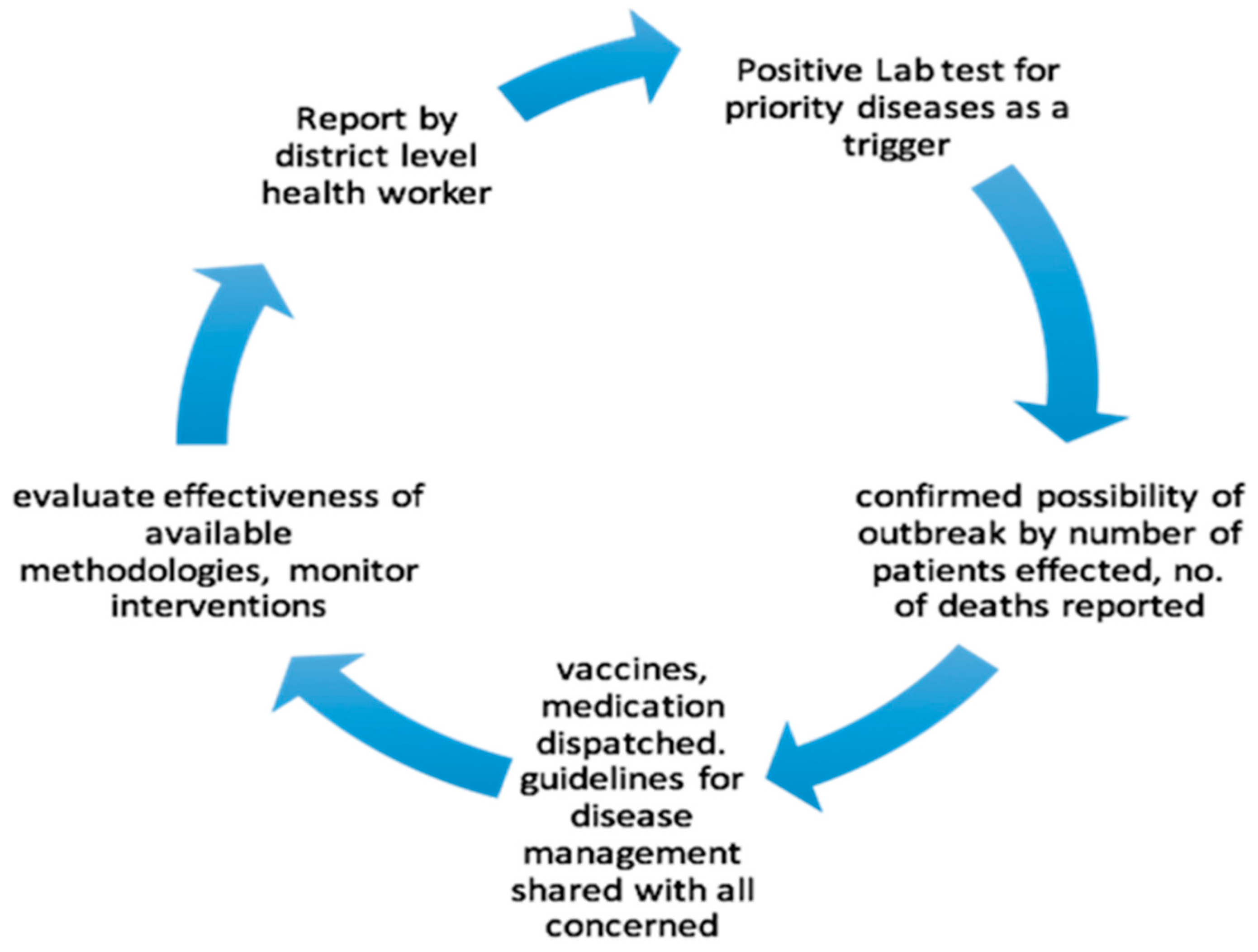The Emerging Role of Blockchain Technology Applications in Routine Disease Surveillance Systems to Strengthen Global Health Security
Abstract
:1. Introduction
2. Understanding a Blockchain and Its Applications
2.1. Definition
2.2. Types and Uses of Blockchain
2.3. Advantages and Limitations of Blockchain Technology
2.4. Role of Blockchain Technology in Healthcare
3. Disease Surveillance Systems
3.1. Definition of Surveillance
3.2. Challenges of Current Surveillance Systems
3.3. Moving towards Real-Time Disease Surveillance through Blockchain
3.4. Use of Blockchain over Other Widely Used Machine Learning Techniques
3.5. Improving Disease Surveillance through Blockchain Applications
3.6. Quality of Experience Perspective
4. Global Health Security and Global Health Security Agenda
4.1. Global Health Security
4.2. What is the Global Health Security Agenda?
4.3. Relevance of Blockchain in the Global Health Security Agenda
4.4. Need for Real-Time Surveillance for Chronic Non-Communicable Diseases (NCDs)
5. Conclusions
Author Contributions
Funding
Conflicts of Interest
References
- Randall, D.; Goel, P.; Abujamra, R. Blockchain Applications and Use Cases in Health Information Technology. J. Health Med. Inform. 2017, 8, 276. [Google Scholar] [CrossRef]
- Angraal, S.; Krumholz, H.M.; Schulz, W.L. Blockchain Technology—Applications in Healthcare. Circ. Cardiovasc. Qual. Outcomes 2017, 10, e003800, Originally Published 14 September 2017. Available online: http://circoutcomes.ahajournals.org/content/10/9/e003800.long (accessed on 17 July 2018). [CrossRef] [PubMed]
- Crosby, M.; Pattanayak, P.; Verma, S.; Kalyanaraman, V. BlockChain Technology: Beyond Bitcoin. Appl. Innov. Rev. 2016, 2, 71. Available online: http://scet.berkeley.edu/wp-content/uploads/AIR-2016-Blockchain.pdf (accessed on 17 July 2018).
- Ekblaw, A.; Azaria, A.; Halamka, J.D.; Lippman, A. A Case Study for Blockchain in Healthcare: MedRec Prototype for Electronic Health Records and Medical Research Data, White Paper Volume 13, p. 13. 2016. Available online: https://pdfs.semanticscholar.org/56e6/5b469cad2f3ebd560b3a10e7346780f4ab0a.pdf (accessed on 27 July 2018).
- McGinn, D.; McIlwraith, D.; Guo, Y. Toward Open Data Blockchain Analytics: A Bitcoin Perspective Royal Society of Open Science. 2018. Available online: https://arxiv.org/pdf/1802.07523.pdf (accessed on 27 July 2018).
- Beck, R.; Avital, M.; Rossi, M.; Thatcher, J.B. Blockchain Technology in Business and Information Systems Research. Bus. Inf. Syst. Eng. 2017, 59, 381–384. Available online: https://link.springer.com/article/10.1007/s12599-017-0505-1 (accessed on 27 July 2018). [CrossRef] [Green Version]
- Tapscott, D.; Tapscott, A. The Impact of the Blockchain Goes beyond Financial Services. Harvard Business Review. 2016. Available online: https://hbr.org/2016/05/the-impact-of-the-blockchain-goes-beyond-financial-services (accessed on 25 January 2017).
- Peterson, K.; Deeduvanu, R.; Kanjamala, P.; Boles, K. A blockchain-based approach to health information exchange networks. In Proceedings of the NIST Workshop Blockchain Healthcare, Gaithersburg, MD, USA, 26–27 September 2016; Volume 1, pp. 1–10. [Google Scholar]
- Abdullah, N.; Håkansson, A.; Moradian, E. Blockchain-based approach to enhance big data authentication in a distributed environment. In Proceedings of the Ninth International Conference on Ubiquitous and Future Networks (ICUFN), Milan, Italy, 4–7 July 2017; IEEE Computer Society: Washington, DC, USA, 2017; pp. 887–892. [Google Scholar]
- Last, J.M. (Ed.) Dictionary of Epidemiology, 4th ed.; Oxford University Press: New York, NY, USA, 2001; p. 61. [Google Scholar]
- Tambo, E.; Ugwu, E.C.; Ngogang, J.Y. Need of surveillance-response systems to combat Ebola outbreaks and other emerging infectious diseases in African countries. Infect. Dis. Poverty 2014, 3, 29. [Google Scholar] [CrossRef] [PubMed]
- Nsubuga, P.; White, M.E.; Thacker, S.B.; Anderson, M.A.; Blount, S.B.; Broome, C.V.; Chiller, T.M.; Espitia, V.; Imtiaz, R.; Sosin, D.; et al. Public Health Surveillance: A Tool for Targeting and Monitoring Interventions. In Disease Control Priorities in Developing Countries, 2nd ed.; Jamison, D.T., Breman, J.G., Measham, A.R., Alleyne, G., Claeson, M., Evans, D.B., Jha, P., Mills, A., Musgrove, P., Eds.; The International Bank for Reconstruction and Development/The World Bank: Washington, DC, USA, 2006; Chapter 53. Available online: https://www.ncbi.nlm.nih.gov/books/NBK11770/ (accessed on 27 July 2018).
- Jonas, O.B. Pandemic Risk; World Bank: Washington, DC, USA, 2013; © World Bank. License: CC BY 3.0 IGO; Available online: https://openknowledge.worldbank.org/handle/10986/163432 (accessed on 27 July 2018).
- Sharma, R. CDC Is Testing Blockchain Projects to Manage Pandemics | October 9, 2017. Available online: https://www.investopedia.com/news/cdc-testing-blockchain-projects-manage-pandemics/ (accessed on 17 July 2018).
- Susan Galer. Betting On Blockchain as a Miracle Cure For The $78 Billion Opioid Crisis. 2017. Available online: https://www.forbes.com/sites/sap/2017/09/12/betting-on-blockchain-as-a-miracle-cure-for-the-78b-opioid-crisis/#6cf773c934d3 (accessed on 17 July 2018).
- Tsui, F.-C.; Espino, J.U.; Dato, V.M.; Gesteland, P.H.; Hutman, J.; Wagner, M.M. Technical Description of RODS: A Real-time Public Health Surveillance System. J. Am. Med. Inform. Assoc. 2003, 10, 399–408. [Google Scholar] [CrossRef] [PubMed] [Green Version]
- Rahouti, M.; Xiong, K.; Ghani, N. Bitcoin Concepts, Threats, and Machine-Learning Security Solutions. IEEE Access 2018, 6, 67189–67205. [Google Scholar] [CrossRef]
- Salah, K.; Habib ur Rehman, M.; Nizamuddin, N.; Al Fuqaha, A. Blockchain for AI: Review and Open Research Challenges. IEEE Access 2018, 7, 10127–10149. [Google Scholar] [CrossRef]
- Mamoshina, P.; Ojomoko, L.; Yanovich, Y.; Ostrovski, A.; Botezatu, A.; Prikhodko, P.; Izumchenko, E.; Aliper, A.; Romantsov, K.; Zhebrak, A.; et al. Converging blockchain and next-generation artificial intelligence technologies to decentralize and accelerate biomedical research and healthcare. Oncotarget 2018, 9, 5665. [Google Scholar] [CrossRef]
- Campbell, D. Combining AI and Blockchain to Push Frontiers in Healthcare. 2018. Available online: http://www.macadamian.com/2018/03/16/combining-ai-and-blockchain-in-healthcare (accessed on 9 January 2019).
- Woods, J. Blockchain: Rebalancing & Amplifying the Power of AI and Machine Learning (ML). 2018. Available online: https://medium.com/crypto-oracle/blockchain-rebalancing-amplifyingthe-power-of-ai-and-machine-learning-ml-af95616e9ad9 (accessed on 9 April 2019).
- Bocek, T.; Rodrigues, B.B.; Strasser, T.; Stiller, B. Blockchains everywhere—A use-case of blockchains in the pharma supply-chain. In Proceedings of the 2017 IFIP/IEEE Symposium on Integrated Network and Service Management (IM), Lisbon, Portugal, 8–12 May 2017; pp. 772–777. [Google Scholar]
- Chen, S.; Shi, R.; Ren, Z.; Yan, J.; Shi, Y.; Zhang, J. A Blockchain-Based Supply Chain Quality Management Framework. In Proceedings of the 2017 IEEE 14th International Conference on e-Business Engineering (ICEBE), Shanghai, China, 4–6 November 2017; pp. 172–176. [Google Scholar]
- Anjomshoa, F.; Aloqaily, M.; Kantarci, B.; Erol-Kantarci, M.; Schuckers, S. Social Behaviometrics for Personalized Devices in the Internet of Things Era. IEEE Access 2017, 5, 12199–12213. [Google Scholar] [CrossRef]
- Cordes, K.M.; Cookson, S.T.; Boyd, A.T.; Hardy, C.; Malik, M.R.; Mala, P.; El Tahir, K.; Everard, M.; Jasiem, M.; Husain, F. Real-time surveillance in emergencies using the early warning alert and response network. Emerg. Infect. Dis. 2017, 23 (Suppl. 1), S131. [Google Scholar] [CrossRef]
- Chattu, V.K.; Kumar, R.; Kumary, S.; Kajal, F.; David, J.K. Nipah virus epidemic in southern India and emphasizing “One Health” approach to ensure global health security. J. Fam. Med. Prim. Care 2018, 7, 275. [Google Scholar] [CrossRef] [PubMed]
- Patterson, J.; Sammon, M.; Garg, M. Dengue, Zika, and Chikungunya: Emerging Arboviruses in the New World. West. J. Emerg. Med. 2016, 17, 671–679. [Google Scholar] [CrossRef] [PubMed]
- To, K.K.; Chan, J.F.; Tsang, A.K.; Cheng, V.C.; Yuen, K.Y. Ebola virus disease: A highly fatal infectious disease reemerging in West Africa. Microbes Infect. 2015, 17, 84–97. [Google Scholar] [CrossRef] [PubMed]
- Petersen, E.; Hui, D.S.; Perlman, S.; Zumla, A. Middle East Respiratory Syndrome–advancing the public health and research agenda on MERS-lessons from the South Korea outbreak. Int. J. Infect. Dis. 2015, 36, 54–55. [Google Scholar] [CrossRef] [PubMed]
- Sikka, V.; Chattu, V.K.; Popli, R.K.; Galwankar, S.C.; Kelkar, D.; Sawicki, S.G.; Stawicki, S.P.; Papadimos, T.J. The Emergence of Zika Virus as a Global Health Security Threat: A Review and a Consensus Statement of the INDUSEM Joint Working Group (JWG). J. Glob. Infect. Dis. 2016, 8, 3–15. [Google Scholar] [CrossRef] [PubMed]
- Global Health Security Agenda. Available online: https://www.ghsagenda.org/ (accessed on 24 December 2018).
- Chattu, V.K. Politics of Ebola and the critical role of global health diplomacy for the CARICOM. J. Fam. Med. Prim. Care 2017, 6, 463–467. [Google Scholar] [CrossRef] [PubMed]
- Global Health Security Agenda—Annual Report. Advancing the Global Health Security Agenda: Progress and Early Impact from U.S. Investment. Available online: https://www.cdc.gov/globalhealth/security/ghsareport/images/ghsa-report-2017.pdf (accessed on 9 August 2018).
- Kostova, D.; Husain, M.J.; Sugerman, D.; Hong, Y.; Saraiya, M.; Keltz, J.; Asma, S. Synergies between communicable and noncommunicable disease programs to enhance global health security. Emerg. Infect. Dis. 2017, 23 (Suppl. 1), S40. [Google Scholar] [CrossRef] [PubMed]
- Jian, S.-W.; Chen, C.-M.; Lee, C.-Y.; Liu, D.-P. Real-Time Surveillance of Infectious Diseases: Taiwan’s Experience. Health Secur. 2017, 15, 144–153. [Google Scholar] [CrossRef] [PubMed]
- Mettler, M. Blockchain Technology in Healthcare: The Revolution Starts here. In Proceedings of the 2016 IEEE 18th International Conference on e-Health Networking, Applications, and Services (Healthcom), Munich, Germany, 14–16 September 2016; pp. 1–3. [Google Scholar] [CrossRef]
- E-Estonia. Available online: https://e-estonia.com/solutions/healthcare/ (accessed on 12 December 2018).
- Abat, C.; Chaudet, H.; Colson, P.; Rolain, J.-M.; Raoult, D. Real-Time Microbiology Laboratory Surveillance System to Detect Abnormal Events and Emerging Infections, Marseille, France. Emerg. Infect. Dis. 2015, 21, 1302–1310. [Google Scholar] [CrossRef] [PubMed] [Green Version]



| Advantages | Limitations |
|---|---|
| 1. Reduced costs and increased efficiency | 1. Cost-effectiveness has yet to be proven |
| 2. Healthcare information remains secure and easily accessible at the same time. Information is automatically updated in real time | 2. Security mechanism to be built in to protect patient data from leaking |
| 3. The transactions are processed by the network, so there is no need to trust a single computer, database, or institution | 3. Regulatory issues and Technical challenges |
| 4. Improvised security by protecting confidential information and reliable protection against “phishing.” | 4. The distributed access to the data set does have the risk for potential compromise although the data within the blockchain can be de-identified and encrypted |
| 5. Provides interoperability to communicate the data to healthcare providers quickly in a meaningful way | 5. The speed and scalability of a completely distributed system need to be addressed as smaller blockchain-based applications still pose some concerns |
| GHSA Category | GHSA Action Package | NCD-Related Activity to Support GHSA |
|---|---|---|
| Detect | Real-Time Surveillance |
|
© 2019 by the authors. Licensee MDPI, Basel, Switzerland. This article is an open access article distributed under the terms and conditions of the Creative Commons Attribution (CC BY) license (http://creativecommons.org/licenses/by/4.0/).
Share and Cite
Chattu, V.K.; Nanda, A.; Chattu, S.K.; Kadri, S.M.; Knight, A.W. The Emerging Role of Blockchain Technology Applications in Routine Disease Surveillance Systems to Strengthen Global Health Security. Big Data Cogn. Comput. 2019, 3, 25. https://doi.org/10.3390/bdcc3020025
Chattu VK, Nanda A, Chattu SK, Kadri SM, Knight AW. The Emerging Role of Blockchain Technology Applications in Routine Disease Surveillance Systems to Strengthen Global Health Security. Big Data and Cognitive Computing. 2019; 3(2):25. https://doi.org/10.3390/bdcc3020025
Chicago/Turabian StyleChattu, Vijay Kumar, Anjali Nanda, Soosanna Kumary Chattu, Syed Manzoor Kadri, and Andy W Knight. 2019. "The Emerging Role of Blockchain Technology Applications in Routine Disease Surveillance Systems to Strengthen Global Health Security" Big Data and Cognitive Computing 3, no. 2: 25. https://doi.org/10.3390/bdcc3020025
APA StyleChattu, V. K., Nanda, A., Chattu, S. K., Kadri, S. M., & Knight, A. W. (2019). The Emerging Role of Blockchain Technology Applications in Routine Disease Surveillance Systems to Strengthen Global Health Security. Big Data and Cognitive Computing, 3(2), 25. https://doi.org/10.3390/bdcc3020025






